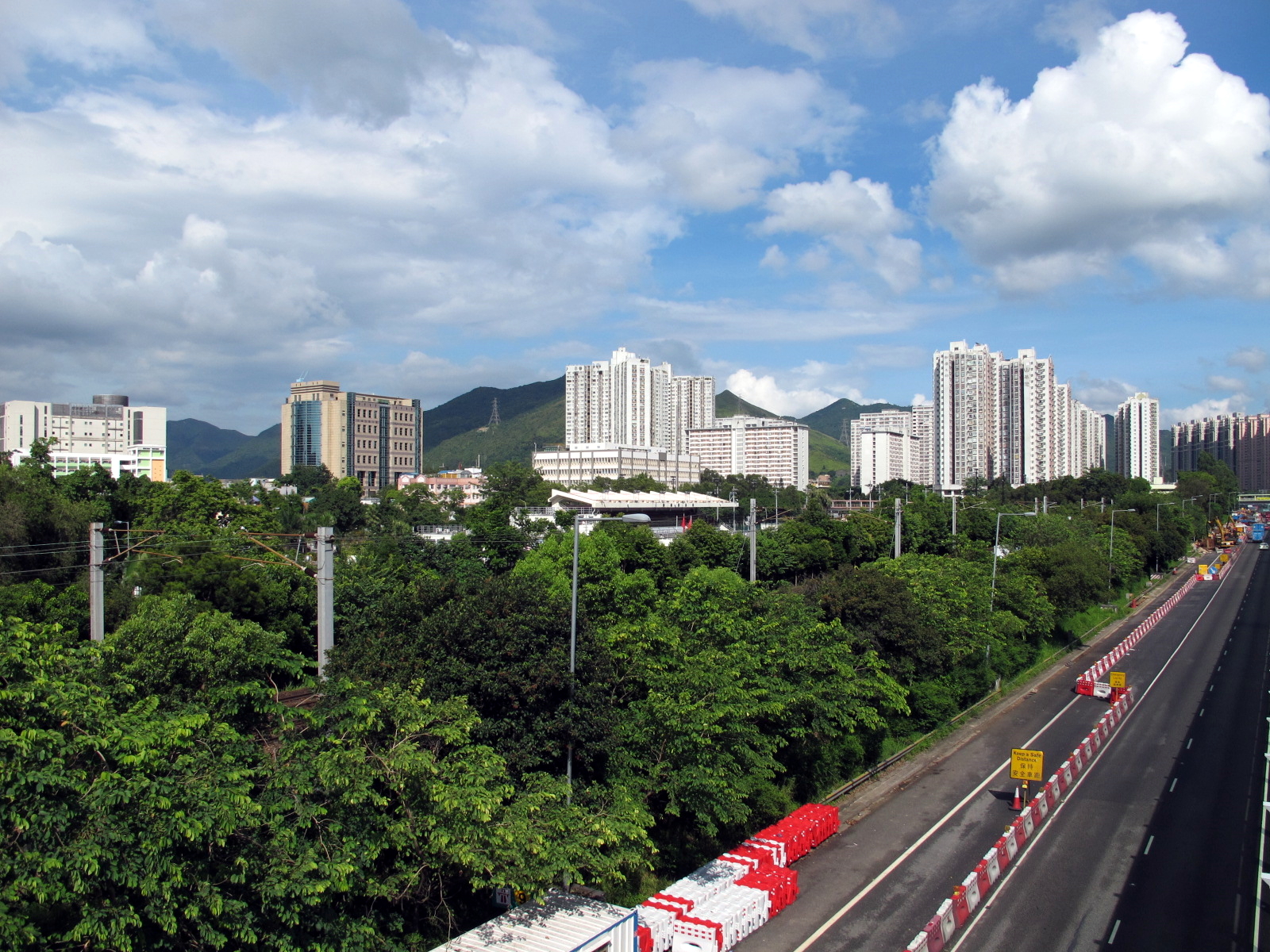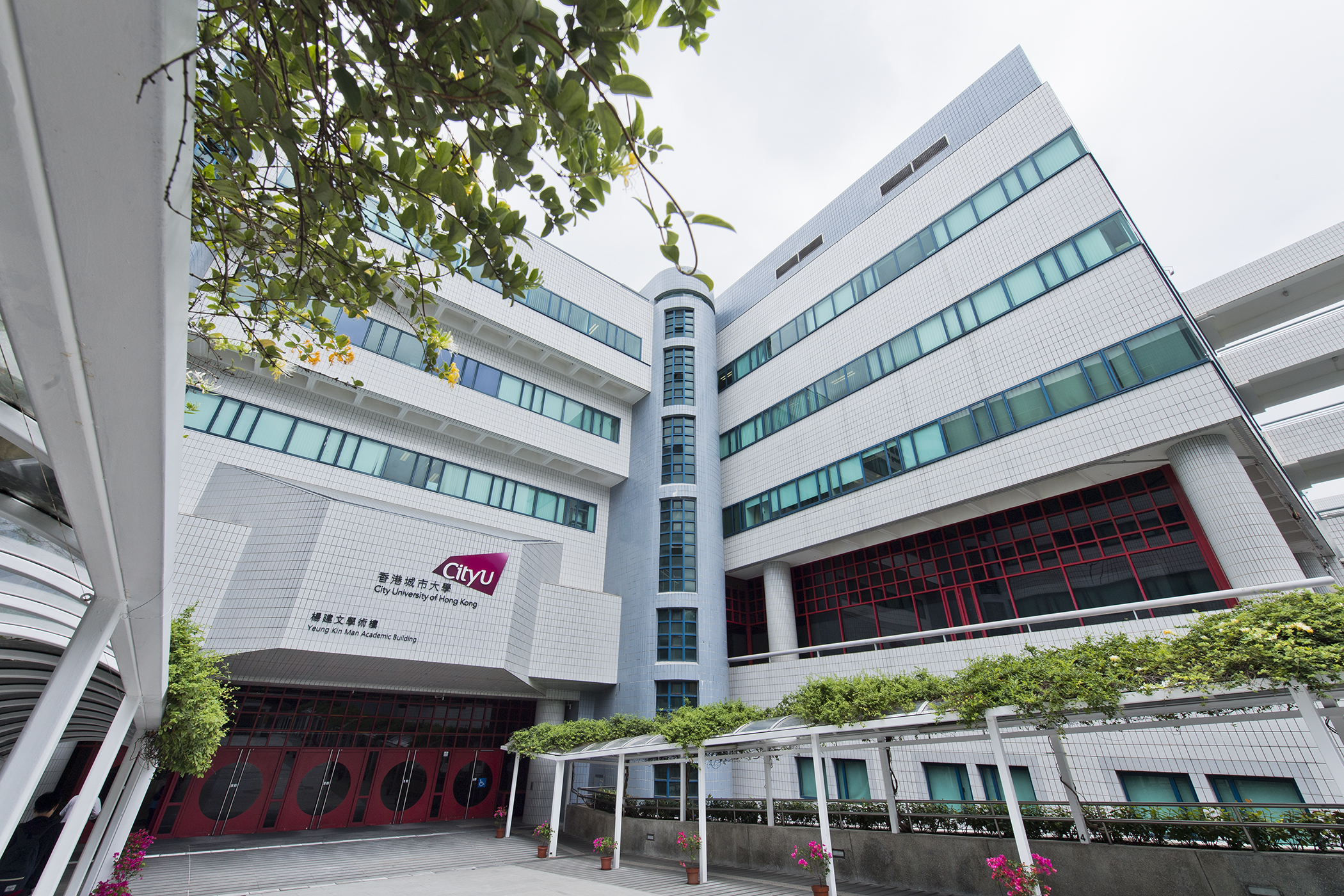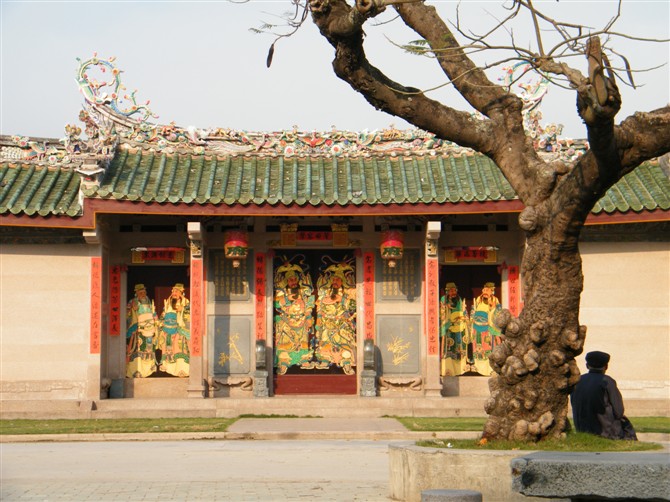|
Tang Chung Ling Ancestral Hall
The Tang Chung Ling Ancestral Hall () is the main ancestral hall of the Tang Clan of Lung Yeuk Tau and one of the largest ancestral halls in Hong Kong.Antiquities and Monuments Office: Declared monumentsTang Chung Ling Ancestral Hall/ref> It is still used for worship and celebrations of traditional festivals and ceremonies, as well as a meeting place for the Tang Clan of Lung Yeuk Tau.Leisure and Cultural Services DepartmentMajor Repair to Tang Chung Ling Ancestral Hall, Lung Yeuk Tau, Fanling August 2004 It is located in between Lo Wai and Tsz Tong Tsuen in Lung Yeuk Tau, Fanling, North District, in the New Territories of Hong Kong.Antiquities and Monuments Office: Lung Yeuk Tau Heritage TrailTang Chung Ling Ancestral Hall/ref> History The ancestral hall was built in 1525 in memory of the founding ancestor, Tang Chung Ling () (1303-1387), the sixth generation descendant of the clan. From the 1940s to the 1950s, the Ancestral Hall was also used as a village school. ... [...More Info...] [...Related Items...] OR: [Wikipedia] [Google] [Baidu] |
North District, Hong Kong
North District () is the northernmost district of the 18 districts of Hong Kong. It is located in the northeastern part of the New Territories. The new town of Fanling–Sheung Shui is within this district. It had a population of 298,657 in 2001. The district has the second lowest population density in Hong Kong. It borders with Shenzhen city with the Sham Chun River. Most major access points to Mainland China from Hong Kong lie in this district. The North District is about in area. Demographics According to statistics, 70% of the district population lives in the public estates in the Fanling–Sheung Shui New Town. 40,000 villagers living around the two town centres and the main rural towns (Sha Tau Kok and Ta Kwu Ling) account for most residents in the district. Islands of the district * A Chau () * Ap Chau Mei Pak Tun Pai () * Ap Chau Pak Tun Pai () * Ap Chau (, Robinson Island) * Ap Lo Chun () * Ap Tan Pai () * Ap Tau Pai () * Chap Mo Chau () * Cheung Shek Tsui () * ... [...More Info...] [...Related Items...] OR: [Wikipedia] [Google] [Baidu] |
Ancestral Shrines In China
An ancestor, also known as a forefather, fore-elder or a forebear, is a parent or (recursively) the parent of an antecedent (i.e., a grandparent, great-grandparent, great-great-grandparent and so forth). ''Ancestor'' is "any person from whom one is descended. In law, the person from whom an estate has been inherited." Two individuals have a genetic relationship if one is the ancestor of the other or if they share a common ancestor. In evolutionary theory, species which share an evolutionary ancestor are said to be of common descent. However, this concept of ancestry does not apply to some bacteria and other organisms capable of horizontal gene transfer. Some research suggests that the average person has twice as many female ancestors as male ancestors. This might have been due to the past prevalence of polygynous relations and female hypergamy. Assuming that all of an individual's ancestors are otherwise unrelated to each other, that individual has 2''n'' ancestors in the '' ... [...More Info...] [...Related Items...] OR: [Wikipedia] [Google] [Baidu] |
Tang Ancestral Hall (Ping Shan)
The Tang Ancestral Hall () in Ping Shan, in the Yuen Long District of Hong Kong, is one of the largest ancestral halls in Hong Kong. Located between Hang Mei Tsuen and Hang Tau Tsuen, and adjacent to the , it is the main ancestral hall of the Tang clan of Ping Shan. The ancestral hall is still used regularly for worship and celebrations of traditional festivals and ceremonies, as well as a meeting place for the Tang clan of Ping Shan. History It was constructed by Tang Fung-shun (), the fifth generation ancestor of Tang Clan about 700 years ago. Features The Tang Ancestral Hall is a three-hall structure with two internal courtyards. The wooden brackets and beams of the three halls are carved with auspicious Chinese motifs. Shiwan dragon-fish and pottery unicorns decorate the main ridges and roofs. There are ancestral tablets at the altar at the rear hall. Conservation The Tang Ancestral Hall of Ping Shan is a declared monument since 2001. It is situated along the Ping Shan He ... [...More Info...] [...Related Items...] OR: [Wikipedia] [Google] [Baidu] |
Tang Ancestral Hall (Ha Tsuen)
Tang Ancestral Hall (), also known as Yau Kung Tong () is an ancestral hall of the Tang Clan, located in Ha Tsuen Shi, in Ha Tsuen, Yuen Long District, Hong Kong. it is a declared monument. Antiquities and Monuments Office. Declared Monuments in Hong KongTang Ancestral Hall, Ha Tsuen/ref> History Tang Ancestral Hall was constructed by the Tang Clan of Ha Tsuen to commemorate their two founding ancestors, Tang Hung-chi and Tang Hung-wai, for establishing the village settlements in Ha Tsuen. Construction of the Ancestral Hall began in 1749 and was completed in 1750. See also * Tang Ancestral Hall (Ping Shan), a declared monument * Tang Chung Ling Ancestral Hall The Tang Chung Ling Ancestral Hall () is the main ancestral hall of the Tang Clan of Lung Yeuk Tau and one of the largest ancestral halls in Hong Kong.Antiquities and Monuments Office: Declared monumentsTang Chung Ling Ancestral Hall/ref> ..., a declared monument References External links * * Antiquities ... [...More Info...] [...Related Items...] OR: [Wikipedia] [Google] [Baidu] |
Ancestral Tablet
A spirit tablet, memorial tablet, or ancestral tablet, is a placard used to designate the seat of a deity or past ancestor as well as to enclose it. The name of the deity or past ancestor is usually inscribed onto the tablet. With origins in traditional Chinese culture, the spirit tablet is a common sight in many Sinosphere countries where any form of ancestor veneration is practiced. Spirit tablets are traditional ritual objects commonly seen in temples, shrines, and household altars throughout Mainland China and Taiwan. Traditional rituals of East Asia General usage A spirit tablet is often used for deities or ancestors (either generally or specifically: e.g. for a specific relative or for one's entire family tree). Shrines are generally found in and around households (for household gods and ancestors), in temples for specific deities, or in ancestral shrines for the clan's founders and specific ancestors. In each place, there are specific locations for individual spirit tab ... [...More Info...] [...Related Items...] OR: [Wikipedia] [Google] [Baidu] |
City University Of Hong Kong Press
City University of Hong Kong (CityU) is a world-class public research university located in Kowloon Tong, Hong Kong. It was founded in 1984 as City Polytechnic of Hong Kong and became a fully accredited university in 1994. Currently, CityU is one of the top 100 universities in the world. The university has nine main schools offering courses in business, science, engineering, liberal arts and social sciences, law, and veterinary medicine, along with Chow Yei Ching School of Graduate Studies, CityU Shenzhen Research Institute, and Hong Kong Institute for Advanced Study. History City University's origins lie in the calls for a "second polytechnic" in the years following the 1972 establishment of the Hong Kong Polytechnic. In 1982, Executive Council member Chung Sze-yuen spoke of a general consensus that "a second polytechnic of similar size to the first should be built as soon as possible." District administrators from Tuen Mun and Tsuen Wan lobbied the government to build th ... [...More Info...] [...Related Items...] OR: [Wikipedia] [Google] [Baidu] |
Education And Manpower Bureau
The Education Bureau (EDB) is responsible for formulating and implementing education policies in Hong Kong. The bureau is headed by the Secretary for Education and oversees agencies including University Grants Committee and Student Finance Office. History The Education Department ( and before 1983) was responsible for education matters in the territory, with the exception of post-secondary and tertiary education. In 2003, the department was abolished and a new bureau, the Education and Manpower Bureau ( abbreviated EMB) was formed. In July 2007, under newly re-elected Chief Executive Donald Tsang, the manpower portfolio was split away to the new Labour and Welfare Bureau, leaving this body as the Education Bureau. The bureau was formerly housed at the Former French Mission Building. Structure The bureau mainly consists of seven branches, which are responsible for different policies. Each branch is led by a Deputy Secretary for Education. *Further & Higher Education ... [...More Info...] [...Related Items...] OR: [Wikipedia] [Google] [Baidu] |
Chinese Clan
A Chinese kin, lineage or sometimes rendered as clan, is a patrilineal and patrilocal group of related Chinese people with a common surname sharing a common ancestor and, in many cases, an ancestral home. Description Chinese kinship tend to be strong in southern China, reinforced by ties to an ancestral village, common property, and often a common spoken Chinese dialect unintelligible to people outside the village. Kinship structures tend to be weaker in northern China, with clan members that do not usually reside in the same village nor share property. ''Zupu''—the genealogy book A ''zupu'' () is a Chinese kin register or genealogy book, which contains stories of the kin's origins, male lineage and illustrious members. The register is usually updated regularly by the eldest person in the extended family, who hands on this responsibility to the next generation. The "updating" of one's ''zupu'' () is a very important task in Chinese tradition, and can be traced back thou ... [...More Info...] [...Related Items...] OR: [Wikipedia] [Google] [Baidu] |
Lung Yeuk Tau Heritage Trail
Lung Yeuk Tau (), commonly known as Lung Ku Tau () and also called Lung Ling () is an area located northeast of Luen Wo Hui in Fanling, New Territories, Hong Kong. Administration For electoral purposes, Lung Yeuk Tau is part of the Queen's Hill constituency of the North District Council. It is currently represented by Law Ting-tak, who was elected in the local elections. Lung Yeuk Tau (including San Uk Tsuen, San Wai, Wing Ning Tsuen, Wing Ning Wai, Ma Wat Tsuen, Tung Kok Wai and Lo Wai) forms collectively a recognized village under the New Territories Small House Policy. Villages Lung Yeuk Tau is home to the Five Wais ( walled villages) and Six Tsuens (villages) () of the Tang Clan. The "Five Wais" () are:Antiquities and Monuments OfficeLung Yeuk Tau Heritage Trail/ref> * Lo Wai () * Ma Wat Wai () * San Wai (), also called Kun Lung Wai () * Tung Kok Wai (), also known as Ling Kok Wai () * Wing Ning Wai () The "Six Tsuen" () are: * Kun Lung Tsuen () * Ma Wat Tsuen () * ... [...More Info...] [...Related Items...] OR: [Wikipedia] [Google] [Baidu] |
New Territories
The New Territories is one of the three main regions of Hong Kong, alongside Hong Kong Island and the Kowloon Peninsula. It makes up 86.2% of Hong Kong's territory, and contains around half of the population of Hong Kong. Historically, it is the region described in the Convention for the Extension of Hong Kong Territory. According to that treaty, the territories comprise the mainland area north of Boundary Street on the Kowloon Peninsula and south of the Sham Chun River (which is the border between Hong Kong and Mainland China), as well as over 200 outlying islands, including Lantau Island, Lamma Island, Cheung Chau, and Peng Chau in the territory of HK. Later, after New Kowloon was defined from the area between the Boundary Street and the Kowloon Ranges spanned from Lai Chi Kok to Lei Yue Mun, and the extension of the urban areas of Kowloon, New Kowloon was gradually urbanised and absorbed into Kowloon. The New Territories now comprises only the mainland no ... [...More Info...] [...Related Items...] OR: [Wikipedia] [Google] [Baidu] |
Fanling
Fanling ( zh, t=粉嶺; also spelled Fan Ling or Fan Leng) is a town in the New Territories East of Hong Kong. Administratively, it is part of the North District. Fanling Town is the main settlement of the Fanling area. The name Fanling is a shortened form of Fan Pik Leng (). The area has several public and private estates. Northwest of Fanling is Sheung Shui and southeast is Tai Po. Areas Part of Fanling–Sheung Shui New Town, Fanling Town includes Luen Wo Hui (), the marketplace of Fanling before urban development in the area, and Wo Hop Shek (), where an uphill public cemetery is located. Fanling North is one of three new development areas currently being planned for North District, in parallel with Ta Kwu Ling and Kwu Tung North. Sights * Fanling Wai (), a walled village. * Fung Ying Seen Koon (), a Taoist temple. * Lung Yeuk Tau Heritage Trail * Tao Heung Foods of Mankind Museum (relocated to Fo Tan in 2008) Housing estates Public and private hous ... [...More Info...] [...Related Items...] OR: [Wikipedia] [Google] [Baidu] |





